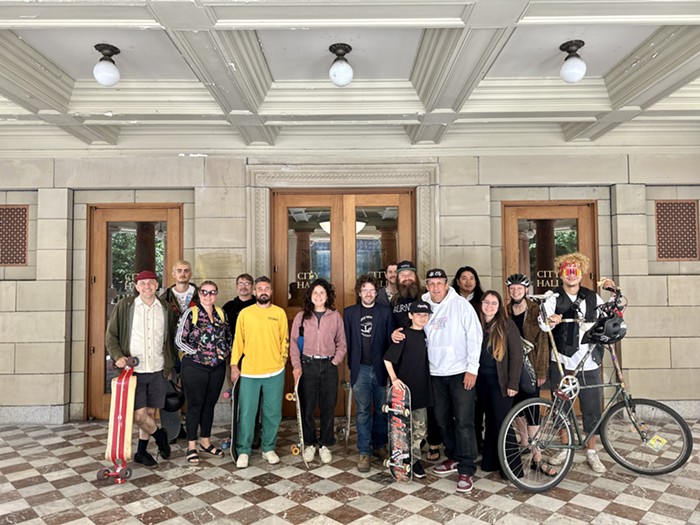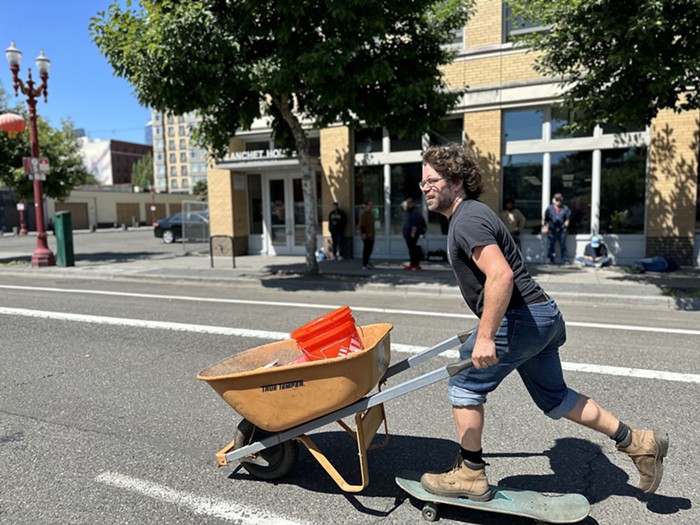Skaters Renew Pressure on Portland City Leaders to Build Steel Bridge Skatepark
Naito #Naito

In honor of this year’s international Go Skateboarding Day, some of Portland’s most dedicated skating advocates took a message to City Council: It’s time to build the Steel Bridge Skatepark.
“Skateboarding is about taking risks and embracing the dance between pleasure and pain. And more than that, it’s about community,” Portland skate enthusiast Katherine Rose told Portland city commissioners on June 21. “[But] not every skatepark is inclusive or safe for everyone, and we want to change that… I wholeheartedly support the Steel Bridge Skatepark because we need more skateparks to incorporate inclusivity and community placemaking from the inception, especially in the west side of our city.”
Proponents of a plan to build a skatepark between Northwest 1st Ave and Northwest Naito Parkway—on the west side base of the Steel Bridge—in Portland’s Old Town neighborhood last made their case to Portland City Council in September 2022. At the time, city commissioners and Mayor Ted Wheeler were intrigued, but cautious. Bureaucratic tensions among City Council members appeared high during the discussion. Then-Portland Bureau of Transportation (PBOT) Commissioner Jo Ann Hardesty was especially concerned about a new skatepark adding pressure for the already-beleaguered transportation bureau—even though Portland Parks & Recreation (PP&R) is the bureau responsible for overseeing the city’s skateparks.
 The group of Steel Bridge Skatepark advocates outside City Hall. (Taylor Griggs)
The group of Steel Bridge Skatepark advocates outside City Hall. (Taylor Griggs)
Nine months later, the landscape at City Hall has changed, and Steel Bridge Skatepark boosters have an optimistic outlook about what’s to come—an attitude backed up by an incoming $250,000 grant from Prosper Portland to fund skatepark pre-development and design services.
Sarah King, Prosper Portland’s Old Town Project Manager, told the Mercury her office has contacted the PP&R project manager to begin an intergovernmental agreement to transfer the funds.
“After that, Prosper won’t really be involved in the financial aspects of the park,” King said.
During the June 21 City Council testimony, commissioners and the mayor gave strong statements of support for the skatepark. Much of the hesitation present last fall seems to have dissipated.
“I know you’ve been waiting for a long time for action on this, so I want to acknowledge your perseverance,” Commissioner Dan Ryan, who’s in charge of PP&R, told the people testifying.
Ryan is right. Skatepark proponents have been waiting a long time. The Steel Bridge Skatepark was included in the Portland Skatepark System Plan back in 2008, and DAO Architecture developed its award-winning design in 2011. Progress stalled in the years since, but members of the Steel Bridge Skatepark Coalition are confident the city is willing to make moves now. And if they don’t, advocates are willing to put in some grunt work themselves.
 Skatepark advocates do some tactical urbanism. (Taylor Griggs)
Skatepark advocates do some tactical urbanism. (Taylor Griggs)
“We’re gonna keep pouring concrete, two feet by two feet, until it’s done or until the city does it,” said Ryan Hashagen, a longtime local transportation activist who owns Icicle Tricycles in Old Town, a few blocks from the proposed skatepark site.
That DIY approach is how Portland got its now-famous Burnside Skatepark underneath the Burnside Bridge.
After testifying at City Council, advocates hopped on their skateboards, hoverboards, and bikes, to roll down to the site they hope will one day house the Steel Bridge Skatepark. Before arriving at the site, Hashagen acknowledged to the group that there are currently quite a few unhoused Portlanders living in tents at the site.
 Rolling to the skatepark. (Taylor Griggs)
Rolling to the skatepark. (Taylor Griggs)
“Let’s be cool neighbors to the folks living at the site,” Hashagen said. Later, Hashagen told the Mercury that members of the Steel Bridge Skatepark Coalition “want to see everyone housed.”
“Our goal is not to displace anyone with the park,” he said, mentioning that it would be years before the building process for the park actually gets underway—for their purposes, nobody needs to relocate immediately.
The vacant Old Town lot between Northwest 1st Avenue and Naito Parkway is co-owned by PBOT and the Oregon Department of Transportation. Transferring the property to complete city ownership may create another bureaucratic speed bump in the road to getting the park built. However, city and state officials have previously indicated their willingness to make the land transfer.
 Hashagen skates to the Steel Bridge Skatepark lot with a wheelbarrow of concrete. (Taylor Griggs)
Hashagen skates to the Steel Bridge Skatepark lot with a wheelbarrow of concrete. (Taylor Griggs)
Hashagen has a notably breezy and affable demeanor—the kind of personality you’d expect from a skateboarder. In some circles of Portland, he’s best known for rollerskating alongside hoards of bicyclists during Pedalpalooza rides. But he’s also one of the city’s foremost public policy experts, and had a key role in projects like the Better Naito Forever bikeway coming to fruition.
Under Hashagen’s leadership, the future Steel Bridge Skatepark has been depicted as far more than just a place where teens can shred on the halfpipe after school. Instead, it represents the revival of downtown Portland. And it’s this framing that may finally stir City Council to act.
“The skatepark will draw people in Old Town, activating downtown and creating a much-needed and welcoming public space to skate,” Hashagen told city commissioners.
“When you first started [advocating for the Steel Bridge Skatepark], there might have been one perception of what you could do to activate the downtown. And I’m hoping today there’s a different perception…so let’s hear it for that type of progress,” Commissioner Ryan replied. “And I really do think it would obviously be a really healthy thing to bring downtown…I’m committed to seeing this through.”
 The Steel Bridge Skatepark Coalition at the skatepark site. (Taylor Griggs)
The Steel Bridge Skatepark Coalition at the skatepark site. (Taylor Griggs)